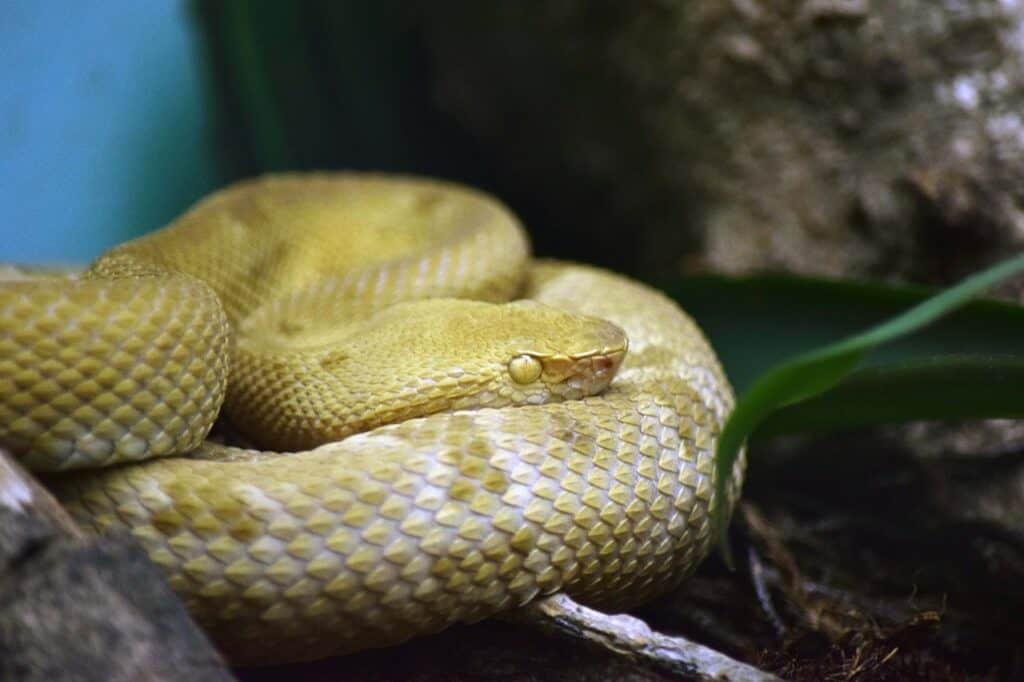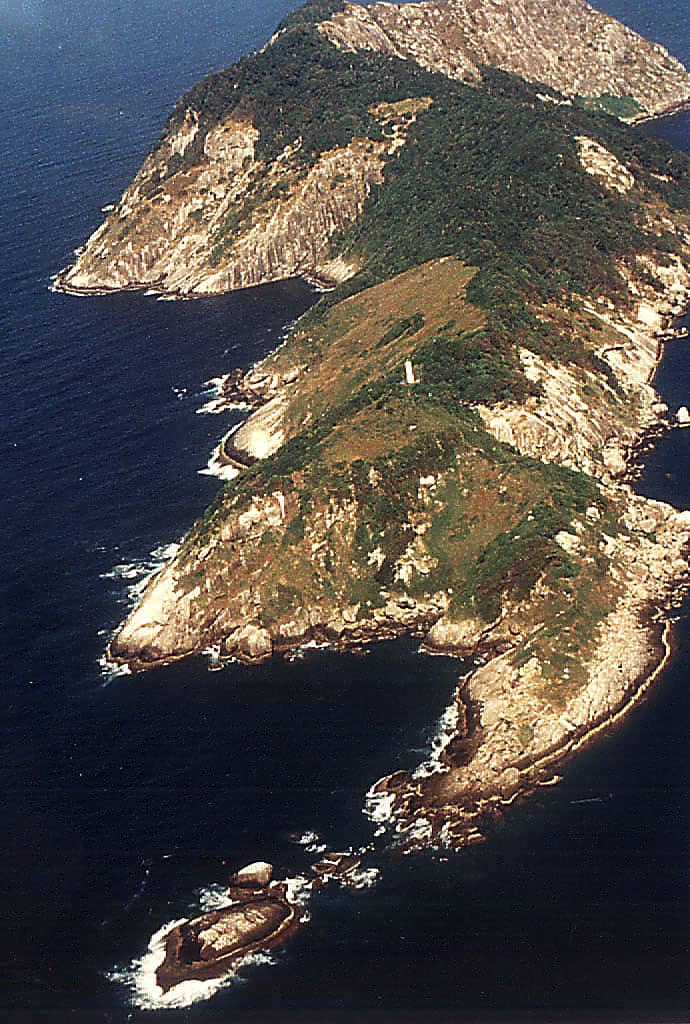Key Points
- 20 miles off the coast of Sao Paulo in southeastern Brazil, there’s a small, uninhabited island called Ilha da Queimada Grande. It is known as Snake Island.
- Bothrups insularis, aka golden lancehead viper, does not exist anywhere else in the world except Snake Island. However, it’s related to the Fer-de-lance- the deadliest snake in the Americas.
- The mortality rate of the golden lancehead’s venom can be up to 7%- especially since help is far away in the event of a bite.
Ophidiophobia is the scientific word for snake phobia. The worst nightmare of a person suffering from this condition would be suddenly finding themselves being dropped to a snake island. It’s only natural to fear these slithering, reptilian, and sometimes venomous creatures who kill thousands of people around the world every year – even without a full-blown phobia. One small island that measures just 430,000m2 or 106 acres in size is so densely packed with snakes that it’s enough to inspire Ophidiophobia in anyone. Today, we’re examining Ilha da Queimada Grande, also known as Snake Island in Brazil.
Snake Island is simply littered with snakes, and they’re not just small constrictors. This island is infested with a venomous cousin of the Fer-de-lance, the deadliest snake in the Americas. Learn the true story of the island as we explore its history and dispel the myths surrounding this harrowing place.
Where is Snake Island Located?

Meet the golden lancehead snake, a resident of Snake Island in Brazil.
©Miguelrangeljr / Creative Commons – License
Ilha da Queimada Grande, also known as Snake Island, is a small island that lies off the coast of the southeastern portion of Brazil. The land is part of the State of Sao Paulo, and it’s noteworthy for having several different terrains, including a small portion of the rainforest.
Snake Island in Brazil is about 20 miles from the mainland coast, far enough away that the snakes can’t reach continental South America. Given the snake’s potent venom, that fact is a relief to many people.
The island’s name doesn’t translate to snake island. Instead, it refers to an attempt at deforestation by burning the island’s vegetation. A massive forest fire started to clear the area for a banana plantation on the island in the early 20th century. Of course, that fell through when the locals realized just how many deadly residents were already living on the island.
Interestingly, the island was home to a lighthouse that housed keepers, but it now operates automatically with annual repairs by the Brazilian Navy.
It’s not hard to find legends about what happened to the last lighthouse keepers. Some claim that the snakes on the island staged a unified attack on them, slithering into their bedroom through the windows and biting the family as they fled in vain and died in the forest. That’s probably not true, though.
What Snake Lives on Snake Island?

Snake Island is the only place in the world that is home to the golden lancehead
©Nayeryouakim / Creative Commons – License
Ilha da Queimada Grande is home to the Bothrups insularis, also known as the golden lancehead viper. This snake is a relative of the mainland’s deadliest snake, the Fer-de-lance. This snake is very noteworthy because it exists only on Snake Island. There is no other place on Earth you can find this animal.
The prevailing theory is that this species became trapped on the island after the last ice age ended over 11,000 years ago. Rising seawater immersed the land connecting Snake Island to the mainland.
The golden lancehead is very distinct. The snake has a light yellow and light brown color, especially on its underside. Also, this snake shares the same unique head shape as the Fer-de-lance, a long head with a point at the nose that resembles a lance’s blade.
The snake is highly dangerous, but let’s parse out the truth about this animal from the larger-than-life myth.
How Dangerous is the Golden Lancehead Snake?
The golden lancehead snake is one of the most venomous snakes in South America. The mortality rate for people that get antivenom is believed to be up to 3%. That number greatly increases if you do not get any treatment, up to a 7% mortality rate. Even if the individual does not die, they will suffer severe damage to their body.
The venom of a golden lancehead is hemotoxic. That means it attacks red blood cells and can cause all sorts of different physical problems. If a golden lancehead bites you, you will suffer from pain, internal bleeding, necrosis of muscle tissue, possible hemorrhages in the brain, and other symptoms.
However, due to the Brazilian government keeping people from visiting the island, no deaths from bites exist in modern records. This snake is not among the most venomous snakes in the world by any measure, but it’s deadly enough to kill humans with ease.
If a person were to sneak on the island and get bitten, the chances are that they would be facing severe health difficulties. After all, they’re about 90 miles from the nearest vial of antivenom.
How Many Golden Lanceheads Live on Snake Island?

Roughly 3,000 snakes are believed to live on Snake Island in Brazil
©Prefeitura Municipal de Itanhaém / Creative Commons – License
With so few people stepping foot on the island, and its reputation for being home to deadly snakes, you would think the golden lanceheads rule Snake Island like reptilian kings. But in fact, the future survival of this rare type of snake is very uncertain.
The number of golden lanceheads on Snake Island is estimated to be between just 2,400 and 2,900 snakes. Given that this is the only place on Earth where these snakes live, they are a critically endangered species of snake.
In the past, estimates claimed that as many as 400,000 snakes or more lived on the island. People thought that there was one snake for every square meter, but that’s just not true. Simply put, there are not enough food resources on the island to sustain a population that large. In fact, there probably never was a food source that was capable of supporting that many snakes in such a small area.
To make matters worse, the mainland deforestation efforts not only destroyed a lot of snakes and their habitat but have also resulted in fewer birds migrating to the island. There is even more competition and less food to go around for the snakes. The population could potentially drop as a result.
Another critical threat to the golden lancehead is poaching. Scientific research and the black market pet trade have made these snakes incredibly valuable. As a result, criminals have tried to capture and smuggle the rare snakes for a potential payout of $10,000-30,000 per specimen.
Instead, there is probably one snake for every 140 square meters. When you consider the small amount of space on the island where the snakes thrive the most, away from the rocky outcroppings, there are still far too many snakes for a person to want to spend time on the land.
What do Snakes eat on Snake Island?
There are no animals on Snake Island – they were no doubt wiped out by the snakes. The snakes prey on ill-fated migrating birds who stop on the island to rest. The snakes wait in trees for the birds to land – and have developed potent, quick-working venom to kill the birds before they fly away.
To make matters worse for the isolated snakes, mainland deforestation efforts resulted in fewer birds migrating to the island. There is even more competition and less food to go around for the snakes. The population could potentially drop as a result.
Can You Visit Snake Island?

If you jump through hoops as a researcher, you can visit Snake Island, but why would you want to?
©Ko biet / Creative Commons – License
The Brazilian government has closed off access to the island to protect humans and snakes. The Brazilian navy restricts access to the island, but they go to the lighthouse to make repairs every year.
Very few researchers have permission to go to the island. When they do go, they must get specific approval, and then they must also have certified doctors accompany them.
Since the snakes on the island are one-of-a-kind, government restrictions may not be enough to stop some criminals from coming to the area. Reports of “bio pirates” who visit the island and acquire snakes for researchers and collectors might be overblown or entirely false given the danger posed by going to Snake Island.
Explore More of Snake Island in Our YouTube Video
In short, Ilha da Queimada Grande is a place that does not quite live up to the legends. Nevertheless, it’s very dangerous and should not be a destination for anyone. Not only would someone face severe legal complications for going to the island without permission, but they just might die. It’s better to admire the golden lancehead from a very long distance away, like through a computer screen.
Bonus: Is There Another Snake Island?

China’s Snake Island is home to 20,000 pit vipers.
©Ondrej Prosicky/Shutterstock.com
You probably thought Brazil’s Snake Island was the only one in the world – but there is another! Off the coast of China’s Liaodong Peninsula in the Bohai Sea is a luscious jungle paradise surrounded by turquoise waters. The beach could be the home of a fabulous tropical resort if not for one problem – snakes – 20,000 venomous pit vipers! Shedao Island is the world’s other snake island – and the only place in the world you can find the Shedao Island pit viper (Gloydius shedaoensis). These snakes have narrowly escaped extinction due to food scarcity and poaching. Like the Golden Lancehead on Brazil’s Snake Island, the Shedao Island pit viper has developed a more potent venom in order to catch its main food source – migratory birds. The island has a surface area of only 180 acres but it is estimated that there is a snake for every 10 square feet.
The photo featured at the top of this post is ©
Discover the "Monster" Snake 5X Bigger than an Anaconda
Every day A-Z Animals sends out some of the most incredible facts in the world from our free newsletter. Want to discover the 10 most beautiful snakes in the world, a "snake island" where you're never more than 3 feet from danger, or a "monster" snake 5X larger than an anaconda? Then sign up right now and you'll start receiving our daily newsletter absolutely free.
Thank you for reading! Have some feedback for us? Contact the AZ Animals editorial team.






